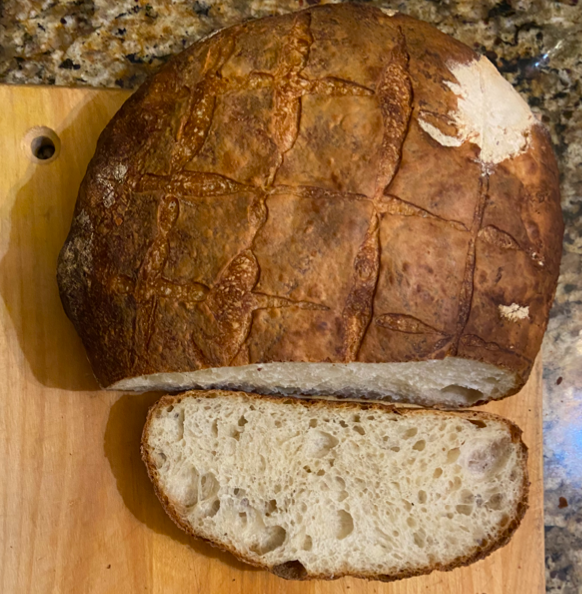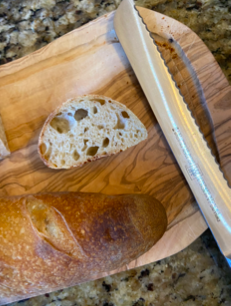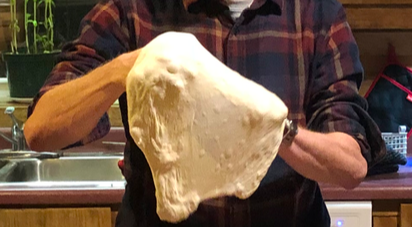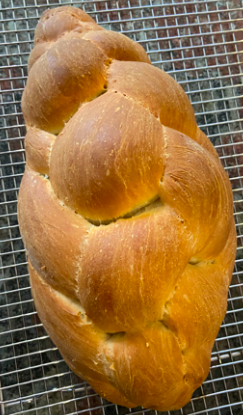Professor Ripstein shares his recipes for sourdough and challah
Professor Arthur Ripstein, a beloved educator, is not only an expert at torts but also an avid baker. He was kind enough to share a couple of his bread recipes with Ultra Vires.
Please note: Ultra Vires and Professor Ripstein are not liable for any baking accidents that may occur while using these recipes.
For all of the recipes, you will know the bread is done when you knock on the bottom of the loaf and it sounds “hollow.” Also, be sure to let the bread cool before eating!
Sourdough Boule/Baguette/Pizza Dough

Ingredients
- 450g keynote flour (the absorption for keynote flour is so great that you actually may need slightly less than 450 g. If you opt for all-purpose or supermarket flour, you will need closer to 500 grams)
- 1g instant yeast
- 80g starter*
- 15g salt
- 1.5 cups tepid/lukewarm water
Method (Sourdough – makes 1 boule)
- Mix the dry ingredients together and add the tepid water. Knead for about 1 minute and then let it sit on the counter overnight.
- Note: with this recipe, if you leave it in the fridge for a few days, the end result will be even better!
- In the morning, fold the dough 5 or 6 times and then turn it out into a basket lined with a floured linen towel (supposedly linen is better for this, but I am not actually confident that the towel I use contains genuine linen).
- Let it rise for 4 to 5 hours. Preheat the oven to 450 degrees Fahrenheit, and then flip the dough out onto a sheet of parchment. Place a pizza steel in the oven while it’s preheating.
- Flipping the dough from its rise position is important. Bigger bubbles will form near the top of the basket because there is less weight on it. When you flip it, you will get a much more even crumb because it is in the opposite direction in the oven.
- A steel is kind of a “fanatic’s” device, but it makes much better bread than a stone.
- You can also use a cast-iron Dutch oven. That is what I use in the summer because I bake outside on the barbecue, and the steel gets too hot so that it burns the bottom before the top is done.
- Brush the top with water, score it, and then slide it onto the preheated steel or Dutch oven (leave the dough on the parchment paper in the Dutch oven).
- Bake for 18 to 20 minutes at 450 degrees Fahrenheit.
Method (Baguette– makes 3 baguettes)

- I have baguette forms (a baking tray used for making baguettes), so sometimes I divide the sourdough into 3 parts and make long strands that rest on what I genuinely believe to be a linen towel. I then gently pull them into the baguette form.
- If you do not have a form, you can also simply flip the dough strands onto parchment paper, but they will be a bit flat on the bottom.
- Use the same baking time and temperature as above.
Method (Pizza Dough– makes 3 pizzas)

- I also use pretty much the same recipe for making pizza, but instead of using bread flour, I use 00 pizza flour (I was skeptical at first but it makes a huge difference).
- Once the dough is made, put the pizza steel by itself on the top rack of your oven and heat to 525 degrees Fahrenheit. Turn the broiler on for about 10 minutes.
- Once the steel is preheated, stretch the dough in the air with your fists and place it on the hot steel.
- Cook for 4 minutes and turn the broiler on for the last minute.
*Lots of people make a big fuss about their sourdough starters, but over the years I have discovered that they are among the most forgiving products. Once, I was driving to visit friends in Nova Scotia and I took my starter in a Tupperware container. It exploded because it built up too much pressure. I was able to scrape some off of the lid, and it all restarted within about 8 hours.
If you use unbleached flour (even more so if you use a little bit of whole-wheat flour), there are wild yeasts and lactobacilli in it already. It will then pick up flavours from the air; my starter had a distinctive taste the year that I lived beside the ocean in Connecticut. So, if you just add equal amounts by weight of flour and water (flour weighs about half of water by volume) and leave it out on the counter for a couple of days, you will be all set.
I keep my starter in a jar in the fridge and every time I use some, I add more flour and water. Periodically, the starter turns kind of brackish, so I just use a little bit of it and start over. A lot of yeast and bacteria activity will become dormant once the alcohol produced as the byproduct gets too high. However, as soon as you pour off the brackish liquid and add more flour and water, the starter will spring back to life.
Challah

I have made challah pretty much every Friday for the last 30 years. It is so familiar that the only thing I measure is the water. But, I would guess the following:
Ingredients (Makes one 6-strand loaf)
- About 350g of flour
- 1 cup of tepid/lukewarm water
- Probably 10g of salt
- Roughly 2 teaspoons of yeast
- 1⁄4 cup oil [the type of oil was not specified, but vegetable oil is assumed]
- 2 tbsp honey
- 1 egg
Method
- Mix the dry ingredients, add water, then add the egg.
- Knead until stiff, around 5 to 7 minutes, and then let it sit for about an hour.
- Braid the dough. See my 6-strand braiding tutorial below if you need help.
- Bake at 375 degrees Fahrenheit for about 35 minutes.
- I used to brush the top with an egg wash before placing it in the oven but ran out one time and everyone liked the bread just as much, so I have not done an egg wash for about the last 15 years.





